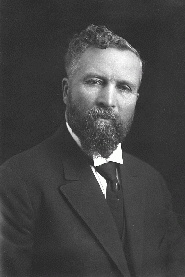
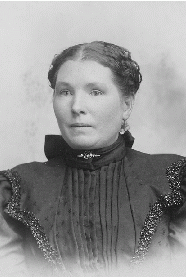


Samuel Chandler Parkinson was born February 23, 1853, in St. Louis, Missouri. His father, Samuel Rose Parkinson, was an Englishman who had emigrated as a boy with his family to Australia, then Chile, then back to England, and finally to St. Louis before Samuel R. was grown. Samuel C.’s mother, Arabella Chandler, was also English and had worked as a dressmaker and milliner to support her widowed mother for years. Arabella’s family joined The Church of Jesus Christ of Latter-day Saints, and when her mother died, she scrimped and saved to buy passage to America. Samuel R. joined the Church in St. Louis, where he and Arabella met and married. Samuel C. was their oldest child. They originally named him William, after Samuel R.’s father, but two years later Samuel R. and Arabella had twins, a girl and a boy. Samuel and Arabella thought it would make better sense to name this pair after his parents. So they named the girl Charlotte and the boy William, and renamed their firstborn after Samuel R.
The Parkinsons crossed the plains by mule team in the William Fields company in 1854, when Samuel C. was a baby. They lived in Kaysward (Kaysville) until 1860, when Samuel C. was 7, and then pioneered in Franklin, Idaho. Samuel C. had four brothers, one of whom died as an infant, and four sisters. They lived in a log cabin at first with a dirt roof. Cloth (like most all trade goods) was scarce, so father and boys wore buckskin the first few years, while Arabella and the girls wore homespun. Samuel R. farmed, ran a sawmill, and had a store. Just after Arabella’s last child was born, when Samuel C. was nearly 14, Samuel R. entered plural marriage, taking to wife Charlotte Smart. Just over a year later he married Charlotte’s sister Maria. Eventually Samuel R. had 32 children.
Mary Ann Hobbs, known as Polly, was also an oldest child. She was born August 15, 1855, to Charles William Hobbs and Mary Ann Emms in Cheltenham, Gloucestershire, England. Samuel’s mother was also from Cheltenham. It’s possible they knew each other, though Arabella emigrated to the United States in 1851, a few month before Polly’s father, Charles, joined the Church, the first in the Hobbs family. Charles and his brother William had gone to a meeting to make fun of the elders but were converted instead, and before long their widowed mother and all their brothers and sisters joined. Polly’s mother Mary Ann Emms joined the Church two years later, in 1853, and married Charles in 1854. Polly was eight years old when she sailed to America with her parents and three siblings. They crossed the plains in the Homer Duncan company in 1862. This was a Church train—twelve Saints were assigned to each covered wagon, which carried provisions and their baggage. Mary Ann walked most the way carrying her littlest child. Since all but the youngest, oldest, and sickest Saints also walked, Polly most likely did too. The family came directly to Franklin, where the Parkinsons were already living. The Hobbses had 13 children and in addition ran a boarding house, so their home was no doubt doubly noisy. Charles also worked a farm in Cove.
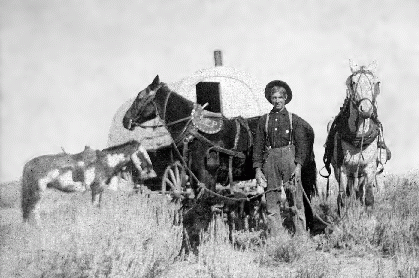 |
| Samuel C. freighting or perhaps herding |
Samuel C. attended the pioneer school but beyond that did not have much opportunity for book learning. He helped his father—Samuel R. ran a thresher, became director of the co-op, and kept livestock. Samuel C. liked to box, wrestle, and hunt. Once he and two other hunters spooked some deer, who plunged over a cliff. The spot became known as Deer Cliff, future site of the Deer Cliff Inn. Though Franklin was a small town with just one ward, it had its own orchestra and put on regular dances. Samuel loved to listen to good music and loved to dance. He played the accordion. Polly, meanwhile, no doubt helped at the Hobbs family boarding house. She had a gentle nature. Her father said of her, “Polly has never sassed me.” Franklin put on plays and had a choir, and Polly was active in both drama and music. Singing especially was a tradition in the Hobbs family.
Samuel was just shy of 10 at the time of the Bear River Massacre. His father brought a Shoshoni boy orphaned in the battle to their home and raised him. He was known as Shem Parkinson. Samuel used to tell of a confrontation that occurred the next year, when an Indian got drunk and ran down Mary Ann Alder with a horse, and Ben Chadwick chased and shot him. This very nearly led to a battle involving the whole of Cache Valley, but the leaders on both sides managed to defuse the situation. The area across the Cub River at the foot of the Little Mountain was full of ground squirrels and rockchucks, and the Indians came there every year to camp and hunt them. In 1874 the Church took up some land in Franklin to teach a band of Shoshonis who had joined the Church how to farm. The Indians, besides improving their own land, hired out to the settlers, who sometimes were stingy and in other cases simply didn’t have money on hand to pay them—cash was rare in Franklin in those days. Finally the Shoshoni Saints staged a dance and invited all the townspeople. The Indians arranged their tents in a circle and held the dance in the center. Admission was free, but afterwards, when the settlers started to go home, the Shoshonis charged them 10 cents each to pass through their lodges. Everyone thought it was a great joke, but they paid up, and so the Shoshonis got some of their money. The farm only lasted one year in Franklin. The band later farmed near Corinne and then in Washakie, where before long they had their own bishop and ward.
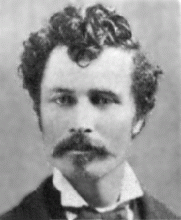 |
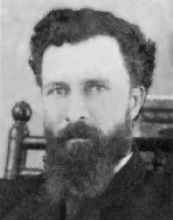 |
| Two shots of Samuel C. as a young man | |
In 1869, when Samuel was 16, his father sent him to Salt Lake to learn carpentry. He apprenticed for two years and returned to Franklin to ply his trade but didn’t like the work and so worked on his father’s farm instead. In 1871 he began freighting between Corinne, over the hill in Box Elder County, Utah, and Montana. Corinne was one of the main supply points for Montana mines. In 1873 the Church completed a railroad line from Salt Lake to Franklin, bypassing Corinne but putting Samuel in an even better position. Freighting was hard work and kept the freighters out in all kinds of weather. They had to guard the goods and teams from hostile Indians. Samuel was on the road in Montana when the Custer massacre took place there in 1876.
Samuel would have known his future wife Polly from church and no doubt socialized with her at the frequent dances and parties the ward put on. Their son Bernice wrote: “At the time he asked for Brother Hobbs’ daughter in marriage, he was told that he could have her if he would pay $85.00 then due on the emigration fund; this he agreed to and the deal was closed. At the time of the marriage, Father had only a $5.00 gold piece in money, which he lost a few days later when he got off his horse to lie down and get a drink in Bear River. So he started his married life with a wife worth a million dollars and $85.00 due on her.” They were married on December 9, 1872, in the Endowment House in Salt Lake City. Samuel was three months shy of 20, and Polly 17. They started having children: Nessie Estella (20 Sep 1873), Edith Arabella (26 Jun 1875—she died 16 May 1877), Samuel William (22 Nov 1876), Mary Hobbs (21 Oct 1878), Albert Hobbs (14 Dec 1880), and Leonard George (27 Sep 1882).
Samuel freighted until 1882, then bought goods for the co-op for a short time. He started a meat market in Franklin with his brothers, which he managed until 1890. In about 1876 he took up a farm on public land west of town and added to it over the years.1 He cleared the willows from the bottomland along the Cub and the sagebrush from the higher ground at the foot of the Little Mountain and made a nice farm of it. The Indians continued to camp on the land at least until the 1890s, when Samuel’s son Bernice remembers playing with their children. (The rockchucks and squirrels they hunted continued plentiful. In the 1930s, when Samuel’s son Roland owned the farm, he used to hire Bernice’s son Blaine to shoot them.) With Samuel gone freighting much of the time, Polly was sometimes frightened or annoyed by the Indians, though they considered many of them friends. Samuel was friendly with them and learned to talk to them. They had many Indian blankets in their home.
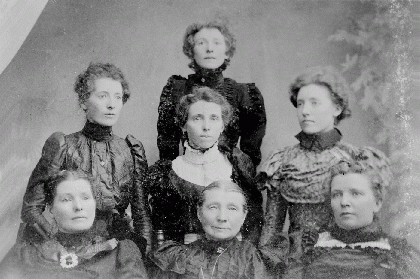 |
| Polly (front left) with her mother (front center) and sisters |
From the time he was a boy, Samuel was active in the Church. From about 1880 to 1884 he was superintendent of the YMMIA (Young Men organization), and he was ordained a seventy. He kept only one journal that we know of. It begins in 1884 like this: “May 1 Received letter from Brother Taylor to go on a mission to the Southern States and to start May 20. Answered letter May 2, no excuse to offer and stating I was ready to go.” Samuel was 31. His oldest child was almost 11, and Polly was four months pregnant with their seventh. (Theresa was born 22 Oct 1884.) Friends and neighbors donated 25 cents, 50 cents, or a dollar or two toward Samuel’s expenses. He attended the dedication of the Logan Temple on May 18 and then left to travel without purse or scrip in Alabama. Polly ran the farm with the help of a hired man named Charlie Peterson. The Indians who camped near their home came to visit often.
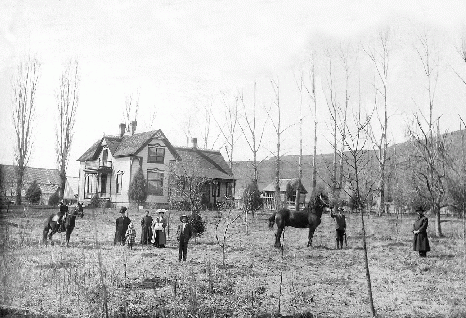 |
| Samuel and Polly’s home in Franklin. L-R: Myrtle, Polly, Roma, a Hobbs relative, Theresa, Roland, Bernice, Samuel |
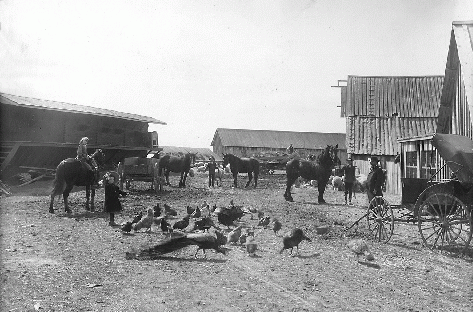 |
| Samuel and Polly’s barnyard L-R: Roma, Myrtle, Roland, Bernice, and Samuel |
 |
| Samuel and one of his horses |
The front of Samuel’s journal lists his personal effects: pocket compass, umbrella, two shirts, celluloid collars and cuffs, comb, glass, towel, razor, soap. The daily entries are brief, but some of the pages are filled with notes to his wife, apparently drafts of a letter:
“It is hard on boots here and Clothing nothing but mountains and timber here. I grant many of the people here is in Slavery as bad as the negroe was before the wore [war]. People is verry deceitful here the most of them. It is hard to tell who is your friend. The Elders onely have one friend that they can depend on and that is the Lord.”
(In fact, while Samuel was laboring, two members and two missionaries in his mission were killed when a mob attacked a Church meeting in Tennessee.) Samuel must have gotten evasive answers from some he contacted:
“A great menny of the wimmin in this Contrey have Children and dont know where they get them. plow run without horse or man. I wonder if I am missed at home. Walnut nut is good for ringworm. . . . Polly it is hard for me to Study I would rather work. . . . I have wore my hat out faning my Self. . . . you know Polly that We live verry well and now it goes rather hard with me. . . . A great many of the people are in a Starving condision. . . .
“Send me word if [the baby] can talk any yet. . . . The cotton fields are white with bools. Your chicken coop is warmer than many of the houses. How is the Little piggs getting A long How many did you keep did the meat I left you Last you till you killed the pigs this fall how mutch flour have you got of that that I left you please let me know.”
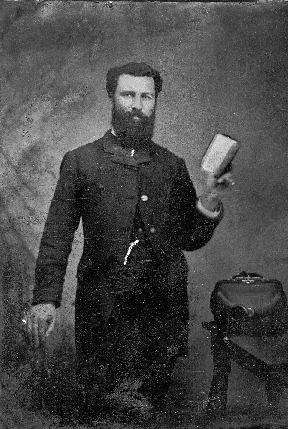 |
| Samuel as a missionary |
Travel without purse or scrip meant missionaries carried little or no money. They depended on the people they taught for their food and lodging. Not all of their time was with non-members, however. Missionaries commonly had networks of members and investigators. They would tract their way to one, work the surrounding countryside, hold meetings, and then tract their way to the next. Samuel kept a running tally of the miles he walked and wrote the names of the families who hosted him. One day he walked 21 miles. Another time he was refused lodging nine times in one day. Often the missionaries helped out with farm work or chores for the people who hosted them. Sometimes they had to deal with drunks at their meetings. Samuel served as president of the Alabama Conference. Toward the end of his mission he sums up: “I have held 34 meetings and Baptized 2 and Blessed 2 children and confirmed 5 and ordained one priest and organized one Branch.” In total he walked over 1600 miles. He was called home early because the anti-polygamy persecutions in Utah had sent so many of the local leadership into hiding. Samuel reported his mission on April 23, 1885. September of the next year he was made a high priest and called as temporary counselor in the bishopric, replacing his father, who was on the underground.
Samuel’s patriarchal blessing states: “Thou shalt be blessed in thy basket and store. Be prudent and all shall be well with thee.” Samuel was prudent, and back in Franklin he grew to be a prosperous man. In about 1885 he began to raise livestock, investing in a herd of Holstein cows and later adding Durhams. His were the first thoroughbred herds in the area. He milked 30 cows twice a day in the days before milking machines and sent 100 gallons of milk a day to the factory. He had the first purebred horses as well, beginning with a Norman stallion in about 1888 and a Englishshire stallion he bought in Kansas in about 1890. Granddaughter Neva Swainston says: “He raised . . . matched teams to sell. He took great pride in caring for them. They were well fed and were fine looking. He loved to ride a nice horse. I can see him now out for his daily ride. He also had a surrey and a cutter that he took pride in hitching a good team to and driving around the country.” He would take Polly with him. One of Samuel’s customers was the Salt Lake fire department, which used teams to pull their fire engines. Joseph F. Smith had a home in Franklin where one of his wives lived. Once Samuel made him a present of a span of driving horses. In 1889 Samuel added sheep to his operation, running as many as 5,000 at a time. His letterhead from the early 1900s says “S. C. Parkinson and Sons, Wholesale Dealers and Shippers of Wool, Live Stock and Grain.” He improved his farm, cared for and groomed his animals, kept his buildings and grounds neat and orderly. He planted numerous trees in his park-like front yard and kept peacocks, wild geese, deer, elk, and antelope there. A metallic arrow perched on a rock in front pointed motorists toward Yellowstone to the north, and tourists often stopped in front of the Parkinson house to look at the animals in his yard.
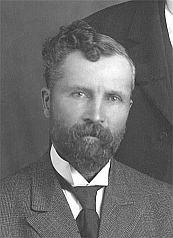 |
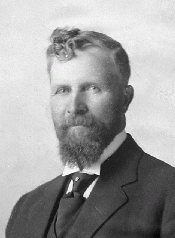 |
| Two shots of a more mature Samuel | |
Polly had difficulty with the principle of polygamy, but she and Samuel had as large a family as some who did live plural marriage. They had six more children during these years: Raymond Charles (12 Jan 1888), Anita (11 Jan 1889), Bernice Richard (pronounced BUR-niss, 12 Apr 1893), Roland Hobbs (8 May 1895), Myrtle Ann (15 Sep 1899), and Roma (17 Apr 1902), for a total of 13. Nephew Preston Parkinson says the Parkinsons had family home evening, “with each child taking his or her turn in prayer, music or storytelling. . . . With a large family of twelve [living] children, as well as hired hands and visitors to feed and entertain, Polly had little time for rest and relaxation except in churchgoing and the frequent Family Home Evenings.” He notes that farmers coming from all over the area to the grist mill across the old highway from their house would camp on the Parkinson land or stay in the Parkinson home. Polly was a tidy housekeeper and good cook, frugal even after they began to have money. One history of Polly says “she was an inveterate reader of good books. Whenever she sat down to rest, if she had no mending in her lap, she always had a good book.” Preston writes: “Dickens, Hugo, Tolstoy and Poe were among Polly’s favorite authors, and she became a good speller.” When Samuel wanted to write a letter, he would say, “Come in here, Polly, and sit down and rest while I write this letter,” and then would rely on her to help him. Polly had a good voice, and they had much singing and music in the home. According to Polly and Samuel’s son Ray and his wife Viola, the Parkinsons had the first Victrola and the first player piano in the neighborhood, and Samuel encouraged the girls to take music lessons.
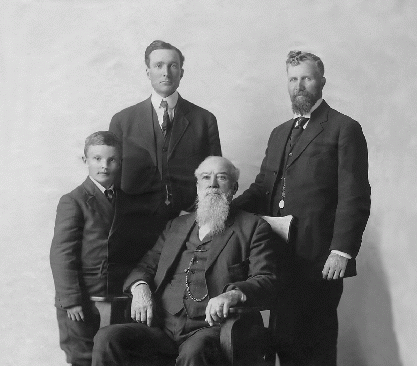 |
| Four generations of Samuel Parkinsons: Samuel Rose (seated), Samuel Chandler (top right), Samuel William (top left), Samuel Taylor |
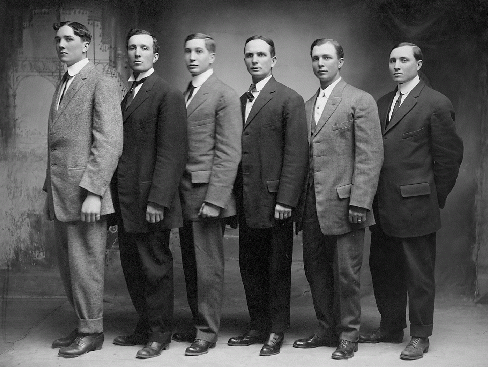 |
| Samuel and Polly’s six sons in order of height. L-R: Roland (the youngest), Samuel W. (the oldest), Bernice, Leonard, Albert, Raymond |
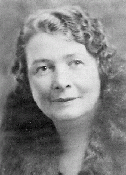 |
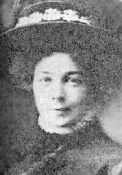 |
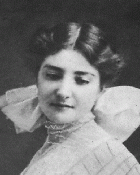 |
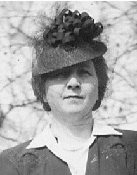 |
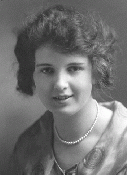 |
| Polly and Samuel’s daughters. L-R: Nessie (Hobbs), Theresa (Brossard), Anita (Smoot), Myrtle (Russell), Roma (Crawford). Missing: May. |
||||
Ray and Viola write:
“Samuel Chandler Parkinson was a fine looking man, walking erectly and with great dignity, always immaculate in dress. He had dark brown, curly hair and, as was the custom in those days, he wore a beard.
“He was a model of neatness, not only in his personal appearance, but also in everything over which he had any jurisdiction. His farm was well-kept and his horses well-groomed. He had a place for everything and everything was kept in its place.
“Being a man of order, this involved hard work not only for himself but for everyone who worked for him. When daylight came, his voice boomed through the house, ‘Everybody up! It is time to take care of the horses, it is time to milk the cows.’ In summer, there was planting to do, grain and hay to haul and all the work that goes with planting and harvesting of crops. Before Samuel went to bed at night, invariably he took a lantern, going outside and walking down around the barns to see if everything was in order, to be sure the animals were fed and safe for the night. . . .
Polly with two of the children “Samuel . . . encouraged his boys to go [on missions], all of his sons going with the exception of one. Samuel and Mary Ann taught their children to be humble, to be prayerful, to keep the Word of Wisdom. Many of the children have stated that family prayers are some of the most beautiful memories they have of their childhood.
Samuel was very frugal and he always advised his children to save fifty cents out of every dollar they earned. His word was as good as his bond. At one time he borrowed ten thousand dollars without signing any papers, his credit being unquestioned. . . . All his life he paid an honest tithe.”
Daughter-in-law Karma and son Bernice wrote impressions of him too: “He was a good judge of people as well as horses. Always counseled his children to live within their means.” They repeat his advice to save 50 cents of every dollar. Ray and Viola mention that “he loved a good joke and a good laugh.” Karma and Bernice add, “Told his boys one morning he didn’t expect them to work too hard but wanted them to get in 20 loads [of hay] that day.” The boys joked and laughed about that one every time they got together for years to come. Karma and Bernice continue with Samuel’s advice:
“Told Raymond when he was stacking hay to keep the middle filled up so rain wouldn’t get in and wet the stack.
“When you put up a fence use good cedar posts, put them in straight, tamp them down, and pull the wires tight.
“If you are going to catch a train go on time.
“If people who were going someplace with him were not ready on time he would go without them. One time we were driving him to Logan and I was slow getting ready. He started out walking. We overtook him by the [railroad] station. I was quite embarrassed.”
Roland’s descendants tell how once Roland delayed at a dance in Lewiston, and Samuel drove off and left him to walk home. Roland didn’t get back to Franklin until early morning, only to have his father tell him, “Alright, now it’s time to do the chores.”
Karma says that after looking over the grounds and animals each night,
“he washed his face, brushed his teeth, and combed his hair like he was going to a party before going to bed. Bernice remembers many nights of being told to get a bowl of warm water and clean towel, a bar of castile soap, and washing his feet for him.
“He never neglected kneeling and having prayers with his family before breakfast and before evening meal.”
A detail from Bernice and Karma that is expanded in Ray and Viola’s account:
“Twice a year before leaving for Conference, Samuel took out his little red book and asked each member of his family what they would like him to bring them from the city. His wife usually said she would like ‘ two wrappers’ (Mother Hubbard dresses). It was always a great day when Samuel returned with all the gifts, usually a bunch of bananas and a box of oranges included with the other gifts. (A rare treat in those days.)”
A few memories from Neva:
“Grandfather . . . was very neat and always well dressed. He stood erect and proud and usually he would wear a flower in the lapel of his coat. He always had candy in his pocket for the children and I can remember the many gifts he used to bring us when he came home from one of his trips. . . .
“He owned one of the first cars around this country, a large Studebaker and he later bought a Cadillac. He used to laugh and say he always wanted to take a car load when he went places so if he had to get out and push he would have plenty of help.
“When I was about 12 or 13 I remember [my father Albert] and I were going to conference in Preston with him—that was when we traveled the old highway and the Worm Creek hill which was quite steep. It had been raining the night before so when we arrived at the bottom of the hill he drove off the side of the road and said, ‘ All right, folks, we’ll walk the rest of the way.’ So we all piled out and proceeded to walk. We really felt foolish when along came a car and picked us up and took us on to conference.”
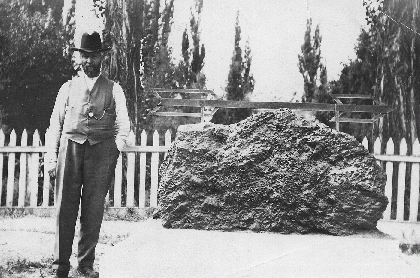 |
| Samuel in front of his house. The arrow pointed the way to Yellowstone. |
Viola and Ray add: “He had a habit of telling people who were riding with him that he would slow down so they could jump out and he would not have to stop and change gears.” Neva continues:
“He . . . kept the Word of Wisdom, including going to bed at 9 o’clock at night. When company would be there at night and 9 o’clock came around he would say, ‘ Well, folks, you are welcome to stay as long as you wish, but it is my bed time so I will leave you now.’”
In February 1898, Samuel and his brother William were called on a short-term mission to the Northwestern States. Samuel was now 45. Many members of the Church had moved to Oregon to work, and Samuel’s and William’s brother George, as stake president of the Oneida, Idaho Stake, was acting as mission president until the mission was organized. William’s history says that William and Samuel “labored very successfully and with great pleasure, opening up missions in Baker City, Walla-Walla, Pendleton, Vianto, Portland, Oregon City, Salem, Vancouver, Astoria, and other places.” According to Jens Westergaard, Samuel worked with George in Portland, where they “attempted to hold meetings at different times and places, seemingly without response.” Jens and his wife Petrine had been converted to the Church years before. In April the Westergaards happened to see a brief article about the missionaries in the Oregonian. Petrine sent Jens in search of them on a bicycle. He spent a full day looking and managed to leave a message where they would be staying. As it happened, this was the last day of Samuel and William’s mission. Their wives Polly and Nellie had joined them, and they had already booked passage on a boat leaving the next morning for California, where they planned to vacation before returning home. “They came the following day, informing me that they intended to make an unfavorable report about sending missionaries to Portland. Sister Westergaard and I advised that elders be sent.” The Church obliged, and the Westergaards soon became the core of the first branch in Portland. Lesson: Work hard until the last day of your mission!
On their way home, they spent a few days in Vancouver, B.C., before continuing to San Francisco, where they met their brother Frank and his wife. An earthquake (not the big one of 1906) hit while they were there. Samuel loved to travel and often went east to sell his sheep. In 1904 or thereabouts he went with his father to visit his Berry relatives in St. Louis and to attend the World Fair.2 Samuel C. encouraged his children to get all the education they could, but according to Bernice’s son Blaine, Samuel C. used to say: “You don’t know much if you ain’t traveled.”
Samuel’s father served as a counselor in the same bishopric in Franklin for 30 years, which they figured was a record. Samuel R. served even after he was made patriarch and even after he moved his wives to Logan and Preston. When he was finally released in 1908, Samuel C. was called to be the new bishop. He served until 1919. George H. Blood, a business associate, characterized Samuel as “just, fair, and equitable,” which must have helped him both with his large family and as bishop. Herschel Bullen, a bishop in Logan, remarked “how careful he was in the settlement of disputes.” One of Samuel’s responsibilities as bishop was to make sure the widows and missionary wives had enough to keep them going. At Christmastime he always butchered cattle and sheep and distributed portions to those in need. Often he would buy a carload of coal and get his sons to help him deliver it around the ward. Neva writes: “I remember being to his place and seeing twelve butchered hogs laying in a row ready to be cut up and cured to be used where it was needed most and he always had at least twelve barrels of apples in his cellar in the fall.” Bernice says he received the assignment from his father to finish up all the ward teaching in the ward at the end of each month. Polly was also active in church service. Her history notes that she “was an active worker in the Relief Society. She was one of the presidency for a number of years. She was very sympathetic and thoughtful of the poor, giving liberally to those in need. She was always a sincere and devoted Latter-day Saint.”
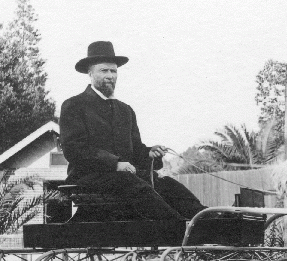 |
| Samuel loved to ride |
Samuel caught smallpox in the winter of 1912 but recovered. Polly came down with a light form but then developed a brain hemorrhage and died just a few days before Christmas, December 21, 1912. She was only 57. (Both her parents outlived her. Charles died the next year, in 1913, and Mary Ann in 1919.) Samuel occupied himself with church and business duties and community affairs. He had an interest in irrigation companies. He was a founder and later president of the Idaho State and Savings Bank of Preston, Idaho, and vice president of the Federal State Bank of Preston. Neva notes that he personally “helped many of his friends and relatives out of financial difficulties and many times without security of any kind.” He was director of the Western Loan and Livestock Company, director of the Aero-Cushion Tire Company of Ogden, director of the Utah-Mexican Rubber Company, and a director of the Utah-Idaho Hospital. Raymond and Viola write that he “was a booster for good roads and good schools.” He served as chairman of the town board, chairman of the county commission, and board member and chairman of the finance committee for Franklin’s first Founders’ Day, which he was largely responsible for getting off the ground. On May 21, 1914, two years after Polly’s death, Samuel married Lulu Ann Carpenter of Logan in the Salt Lake Temple. Seven years later, in February 1921, they moved to Salt Lake City. Samuel died the year after, May 20, 1922, at the age of 69.
Notes
1. According to Progressive Men of Bannock, Bear Lake, Bingham, Fremont, and Oneida Counties, Idaho, Samuel and Polly moved to their farm in 1876. However, the town plot in the Franklin Relic Hall places this in 1877, and some of the other dates in Progressive Men, notably their marriage and Samuel’s mission, are off by a year. The deed books on file for Franklin at the Family History Library list land purchases in 1879–81, though it is possible Samuel was living on the land previously (see film 1451052 item 3). Karma Parkinson writes that he bought farms from Jim Frew, Henry Perry, Dave McClain, and Tom Thomson, all missing from the deed book and so probably in later years. By 1904, according to Progressive Men, Samuel owned 800 acres, a large holding for that day.
2. Neva says he went to an unspecified World’s Fair in 1906 at the same time as a trip with his father to St. Louis. Ray and Viola say he went to the St. Louis World’s Fair but don’t give a year. The St. Louis fair was in 1904. There were fairs in other American cities in 1905 and 1907 but not 1906. Samuel R. Parkinson’s journal describes going to the 1904 St. Louis fair but doesn’t mention Samuel C. being there.
Sources
Samuel C. Parkinson, Missionary Journal (1884); available on microfilm from the Family History Library (0237817 item 7); transcript by Mary Etta Parkinson, 2002.
“Mary Ann Hobbs Parkinson” 2 pages, no date, no author; the copy in the Daughters of Utah Pioneers Museum library lists “Carma Parkinson” as the author, but this is probably a mistake—this copy was likely submitted by Karma Parkinson, who is not the right age to have written it.
Neva P. Swainston, “Samuel Chandler Parkinson” (no date, before 1964), 3 pages. Neva is Albert’s daughter. I used Karma Parkinson’s copy of this history, which includes handwritten corrections she and Bernice made, together with 3 pages of additions, intended for Raymond and Viola Parkinson as they prepared their history (see below).
Raymond C. and Viola B. Parkinson, “Samuel Chandler Parkinson” (1964), 8 pages (2 per legal sheet). These two histories are also available from the Daughters of Utah Pioneers.
Bernice R. Parkinson, “Biography of Samuel C. Parkinson,” 5 pages handwritten, in my possession. The last two page are a history of Mary Ann, and I have circulated it separately under the title “Biography of Mary Ann Hobbs Parkinson.”
Preston W. Parkinson, “Samuel Chandler Parkinson,” in The Family of Samuel Rose Parkinson (2001), 146–51. This sketch includes details from Bernice’s history and the obituary from the Logan Republican.
“Samuel C. Parkinson,” in Progressive Men of Bannock, Bear Lake, Bingham, Fremont, and Oneida Counties, Idaho (Chicago: A. W. Bowen & Co., 1904), 341–42; good data on Samuel’s professional life.
“Samuel C. Parkinson,” in An Illustrated History of the State of Idaho (Chicago: The Lewis Publishing Company, 1899); no author listed; pp. 722–23.
“Funeral Services Held for Pioneer of Idaho in Oldest Settlement,” Deseret News, 27 May 1922; fairly detailed biographical sketch.
“Many Pay Tribute at Parkinson Funeral,” Logan Republican, 25 May 1922; included in Preston Parkinson’s account. Summarizes the speakers at Samuel’s Logan funeral.
Scott R. Christensen, Sagwitch: Shoshone Chieftain, Mormon Elder, 1822–1887 (Utah State University Press, 1999). Details of the Indian farm in Franklin.
“William Chandler Parkinson,” 4 pages. William’s life parallels Samuel’s in many ways. Quoted here for his summary of the Northwestern States mission.
Jens Christensen Westergaard, in “A Latter-day Saint,” Treasures of Pioneer History, comp. Kate Carter (Daughters of Utah Pioneers, 1952–57), 1:308–15. This quotes Westergaard’s autobiography on the establishment of the Church in Portland.